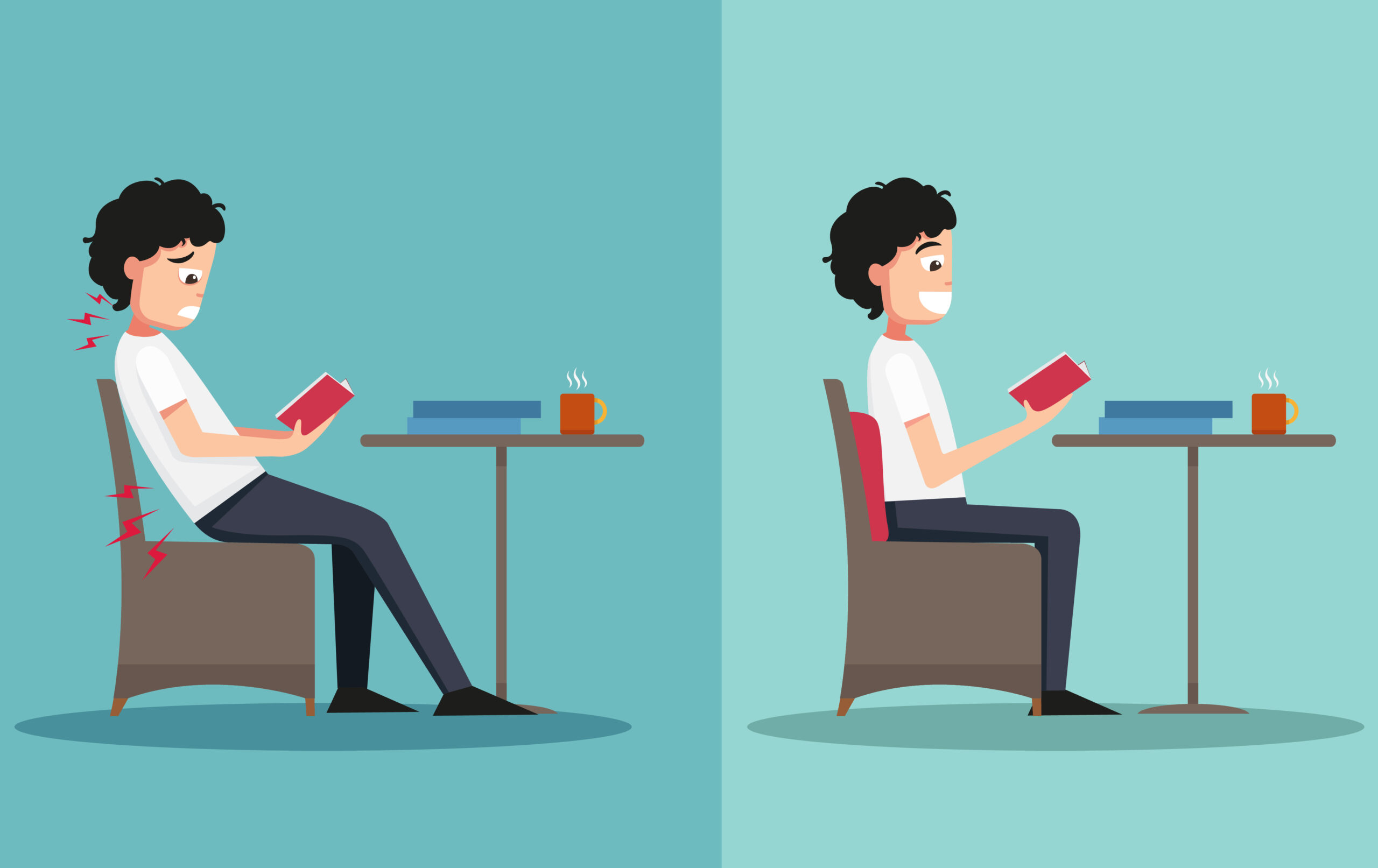In today’s fast-paced world, many of us spend a significant portion of our day sitting, whether it’s at work, while commuting, or during leisure activities. Prolonged sitting can lead to various health issues, including back pain, neck strain, and poor posture. To help you maintain good health and comfort, this blog article will guide you through the ideal sitting posture and offer tips on selecting the right chair for your needs, while also shedding light on the adverse effects of prolonged sitting, with insights from our experienced physiotherapists.
The Ideal Sitting Posture:
1. Chair Placement:
- Choose a stable, adjustable chair with good lumbar support. Make sure your feet can rest flat on the ground or on a footrest.
- Sit at the back of the chair, so your lower back is supported by the lumbar curve of the chair.
- Maintain a small gap between the edge of the chair and the back of your knees.
2. Body Alignment:
- Keep your feet flat on the ground or footrest, with your knees at a 90-degree angle.
- Your hips should be positioned slightly higher than your knees, promoting proper lumbar curvature.
- Maintain a neutral spine position, avoiding excessive arching or slouching.
3. Armrests and Desk:
- Adjust armrests so that your forearms are parallel to the ground when typing or using a computer mouse.
- Ensure your desk is at the right height to prevent hunching or overreaching.
4. Monitor Placement:
- Position your computer monitor at eye level to reduce neck strain. Use a monitor stand if needed.
- Maintain a distance of about 20-24 inches (50-60 cm) between your eyes and the screen.
5. Breaks and Movement:
- Take regular breaks to stand, stretch, and walk around, promoting blood circulation and reducing muscle fatigue.
- Consider using a standing desk for part of your workday to vary your posture.
Selecting the Perfect Chair:
1. Lumbar Support:
- Opt for a chair with adjustable lumbar support that fits the natural curve of your lower back. This helps maintain the ideal posture.
2. Seat Depth and Cushioning:
- Choose a chair with a seat depth that allows you to sit back with your feet flat on the floor while keeping a small gap behind your knees.
- Ensure the cushioning is comfortable and supportive.
3. Adjustability:
- Look for a chair with multiple adjustment options, including seat height, armrest height, and backrest tilt. This allows for customization to your body’s needs.
4. Material and Breathability:
- Consider the material of the chair upholstery. It should be breathable to prevent excessive sweating and discomfort.
5. Test Before You Buy:
- If possible, try out different chairs before making a purchase to ensure comfort and suitability.
Understanding the Adverse Effects of Prolonged Sitting:
Prolonged sitting can have several detrimental effects on your health, including:
- Musculoskeletal Issues: Back pain, neck strain, and poor posture can result from improper sitting habits.
- Poor Circulation: Reduced blood flow in the legs can increase the risk of blood clots, deep vein thrombosis (DVT), and varicose veins.
- Weight Gain: A sedentary lifestyle often leads to weight gain and obesity.
- Cardiovascular Health: Sitting for extended periods can contribute to heart disease and cardiovascular issues.
- Metabolic Issues: Insulin sensitivity decreases with prolonged sitting, increasing the risk of type 2 diabetes.
- Muscle Weakness and Imbalance: Prolonged sitting can lead to muscle atrophy and imbalances.
- Digestive Problems: Sitting for too long can slow down digestion and lead to digestive discomfort.
- Mental Health Impact: Prolonged sitting can contribute to feelings of stress, anxiety, and depression.
- Reduced Lung Capacity: Sitting improperly can restrict lung capacity and lead to shallow breathing.
- Postural Deformities: Over time, sitting with poor posture can result in permanent postural deformities.
- Increased Risk of Injury: Poor sitting habits can increase the risk of injury during physical activities.
- Impact on Longevity: Several studies suggest that sitting for prolonged periods is associated with a shorter lifespan, even among those who exercise regularly.
Conclusion:
Maintaining the ideal sitting posture and choosing the right chair are essential for preventing musculoskeletal issues and promoting overall well-being. By following the guidelines outlined in this article and being aware of the adverse effects of prolonged sitting, you can create a comfortable and ergonomic workspace or leisure environment. Remember that your body is unique, so don’t hesitate to consult with a healthcare professional or physiotherapist for personalized advice if you experience persistent discomfort or pain while sitting. Your health and comfort should always be a top priority




